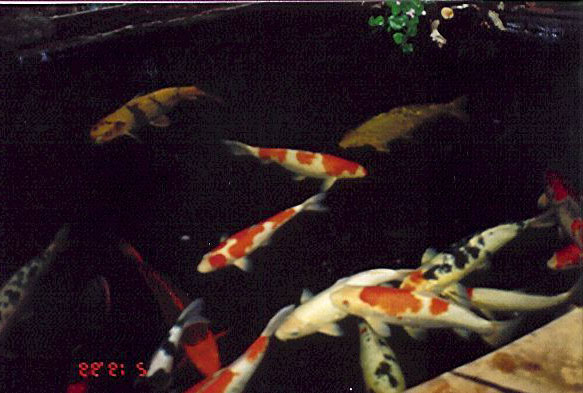Fish in a Garden Pond

Many kinds of small, hardy fish thrive in a modest-sized pond. Different varieties of cold water fish range in size from small, young goldfish to giant koi. Koi may reach a length of 3 feet in a large pool
Preparing your Pond for Fish
Before you introduce fish to the pond, you will need to do some things to aid their survival. Allow your freshly-filled pond to stand for 24 hours to settle. Add Tetra Pond Aqua Safe to tap water to remove chlorine compounds.
As an added precaution, if you have used concrete in your pond, take a pH reading to find out the pH of the water. A pH reading of 8.5 most likely contains dissolved concrete, too alkaline for fish to survive. A pH reading between 6.5 and 8.4 is needed to sustain healthy fish.
Hardy fish can adjust to a range of temperature, but a sudden shock to cold water may harm the fish. Wait until water temperatures warm into the low 60’s before adding fish from indoor tanks to outside pond. Small fish have little chance of surviving a drop of more than 15° .
Introducing Fish
Go slowly! To begin, add just a few fish to your pond; maybe 12 small goldfish to test the water. An established pond can support 1" of fish for every 3 to 5 gallons of water. Add fish over several months, and remember your fish will grow fast and reproduce.
Fish are usually sold in plastic bags. Before you release the
fish, allow the opened bag to float in the water, while slowly adding water from
the pond to the bag. This allows both the pH and temperatures to equalize. After
30 minutes, release the fish. Your fish will dive for the bottom looking for
shelter, but will soon surface looking for food.
Caring for Pool Fish
In Colorado, with at least 24" water depth and care, koi and goldfish can be left in the pond year-round. During the summer they are very active and eat often. If you have more than just a handful of fish, you will want to supplement their natural food of leaves, algae and insects. You can feed frequently, every day feedings help tame your fish. As a general rule, feed no more than what can be consumed in 5 minutes.
As Fall approaches and water cools, the metabolism of the fish slows, and at 45° they will stop eating and go to rest at the bottom of the pond, waiting until the water warms again in the spring.
Never do a super cleaning of the pond. In the Fall, take care to remove old leaves and silt from the pond bottom by running a net along the bottom. In the spring, when the fish start to swim and the water warms, skim the net along the bottom of the pool to remove debris. You may use a sump pump to remove silt and up to 50% of the pond’s water. Remember, the fish feed on algae in the pool. Be sure to add water conditioner when adding more than 5% of the water’s volume.
As long as ice doesn’t cover the pond for weeks at a time, fish can survive the winter. Placing a water pump just under the water’s surface can keep the water open all winter. In a pinch, set a pot full of boiling water on the ice. Never break the ice or you may harm the fish. Floating pond heaters are also useful to keep the surface open.